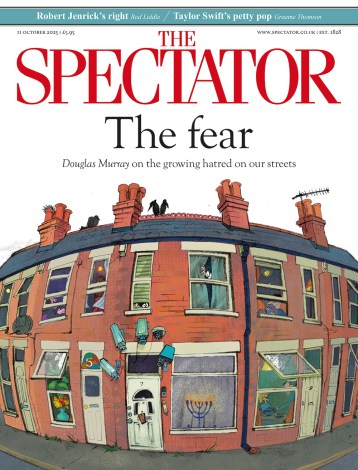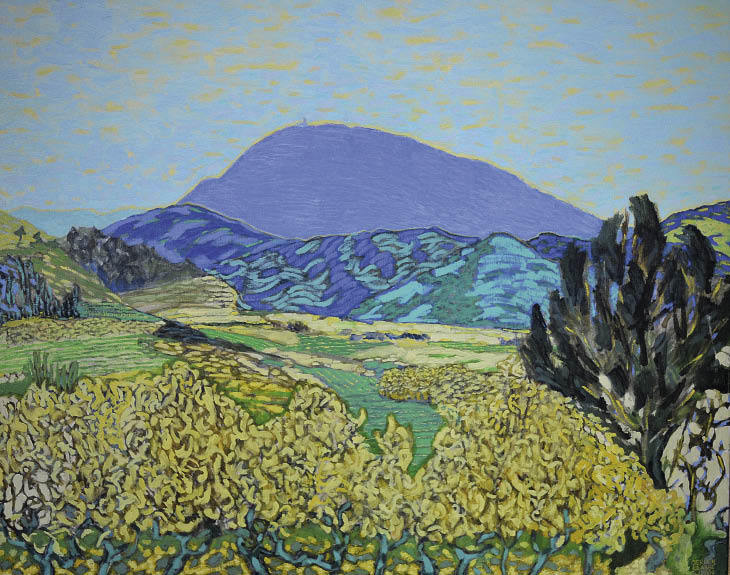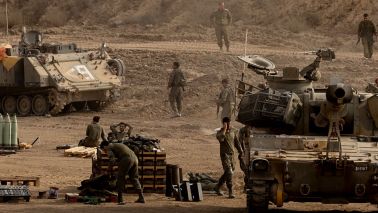The run-up to Christmas is the perfect season for an exhibition of Andrew Logan’s joyful and extravagant art.
The run-up to Christmas is the perfect season for an exhibition of Andrew Logan’s joyful and extravagant art. At Flowers (82 Kingsland Road, E2, until 31 December) is an installation of glittering sculptures which lightens the spirit and brings a song to the lips. Fashion meets fantasy in Logan’s signature mirror sculptures, his unique blend of resin, glass, fibreglass, paint and glitter. For the past 40 years, Logan (born 1945) has brought colour and light into people’s lives. He was a pioneer of the sensational long before the YBAs toddled into view; revealingly, Sir Norman Rosenthal, chief enabler of the YBAs, is a long-time admirer of Logan. Now, in a show appropriately called Rejoice, Logan salutes the tinsel season in his own inimitable way.
The visitor steps into a wonderland of freestanding sculptures — three variants of Pegasus, Logan’s trademark winged horse, in black, red and white, and mirrors cut into portraits and intensively decorated. Here is Derek Jarman with a stack of driftwood for hair, a witty allusion to his home on the beach at Dungeness. Over there are Fenella Fielding, Zandra Rhodes in the manner of Klimt, the late Freddy Gore with a vibrant great dangling canvas tie, and a vast but splendid portrait of the flaxen-haired Angela Flowers. The classical collides with the surreal, and some of Logan’s objects resemble the props in the Twenties photographs by Angus McBean.
In a back room, a film of the 2009 version of Logan’s celebrated Alternative Miss World competition is running, in which his playful but determinedly anarchic spirit can be seen in action. The whole show represents the triumph of kitsch, an extreme position that commands respect. Logan is so resolutely fey that his whimsicality (if that’s what it is) is now ironclad. And it’s still glitter, glitter all the way. Some people complain that his art has not evolved over the past 20 years. Does this matter? What he does, he does supremely well, and lifts the hearts of the many who couldn’t care less about stylistic development. Others prate of significance and meaning. Is this art only mirror-deep? Take care you don’t fall in.
In Cork Street the serious face of contemporary art practice may be found, if you look hard enough. At the Redfern Gallery (until 17 December) is an impressive exhibition of new paintings by Sarah Armstrong-Jones (born 1964), the subjects mostly landscape, still-life and interior. Refreshingly, and despite considerable success, Armstrong-Jones seems unwilling to rest upon the laurels of past achievement and remains intent on pushing her art further. This has resulted in some memorable images in her current show, particularly of sweet peas and branches of foliage. She takes risks with her imagery and, if I can’t share her enthusiasm for field gates, I can enjoy her liquid handling of paint, both in oil and gouache.
By contrast, Marc Vaux (born 1932) has deliberately reduced his vocabulary to a geometric minimalism of anodised aluminium, cellulose and acrylic on MDF. He makes wall-reliefs: angular metal structures which repose upon coloured supports, yet they are the reverse of austere. In fact, these new works, on show at Bernard Jacobson Gallery (until 23 December), are some of the most expressive and exciting of his career. Vaux has liberated his forms and flung wide his boundaries. The aluminium structures, all irregular quadrilaterals, are still the primary element, with their signature inner lining of variously coloured wood.
But these have been placed in a new context: set on large shaped boards whose colours change where the aluminium framework touches their edges. The overall shape is now a circle or an oval, or a diptych or triptych of abutting squares. The work as a consequence has a new dynamism and a new serenity. In the back room is a group of pastel and crayon working drawings for as little as £500: excellent value for this considerable artist.
An exhibition I am much looking forward to, but which had yet to open at the time of writing, is the latest exposition of paintings by the Dutch artist, Jeroen Krabbé (born 1944) at Francis Kyle Gallery (9 Maddox Street, W1, until 24 February 2011). Krabbé is a sumptuous painter whose sense of colour and tactility put him among the best contemporary poets of place. He is evidently mad about pattern, and seeks it out in nature, exaggerating it wonderfully for our visual delectation. His paintings are striped and braided, gorgeously curvilinear, flowing with cascades of brilliant texture and dynamic colour. The images move and vibrate optically, giving an impression of the living land, the radiant colours making the most daring but successful contrasts and oppositions. Krabbé travels widely and paints what he sees: Argentina, France, South Africa, or the islands of Mauritius and La Réunion. For those who enjoyed Gauguin’s landscapes, here’s a treat in store.
In Bath there are shows of new work by two artists whose careers I have followed with great interest: David Tress (born 1955) and Halima Cassell (born 1975). Tress is showing at the Victoria Art Gallery (until 6 February 2011), an exhibition entitled Landmarks, comprising new paintings and graphite drawings, mostly of Bath and the surrounding villages. Tress lives in Wales, but loves to go off researching an area, discovering its nature and revealing it (to himself and then to us) through his images. He has a keen eye for the character and history of landscape and a passionate appreciation of vernacular architecture.
Cassell is that rare thing, a potter who is also a sculptor, an artist whose understanding of form is fundamental and instinctive, and whose investigation of her own cross-cultural inheritance brings to her vessels a richness and breadth of geometric invention. She is showing new sculptures in bronze and carved clay at Beaux Arts Bath (until 24 December).
Finally, back in London, the seasonal show at Chris Beetles (8 & 10 Ryder Street, SW1, until 8 January 2011) is The Illustrators: The British Art of Illustration 1870–2010. Beetles has made a speciality of the subject, and is currently compiling a popular history of it for Thames & Hudson, and his annual show (with lavish accompanying catalogue) has become a favourite destination for those who love draughtsmanship and watercolour.
I have space only for a few highlights, but let me mention Kathleen Hale’s much-loved Orlando, Thelwell, a poignant group of John Ward’s book illustrations, Ronald Searle, Brock, Teniel, du Maurier and Charles Keene (one of my favourites, an enthusiasm shared with Sickert), not forgetting Bateman, E.H. Shepard, Louis Wain, Mervyn Peake, Eric Fraser and Quentin Blake. A veritable feast.






Comments